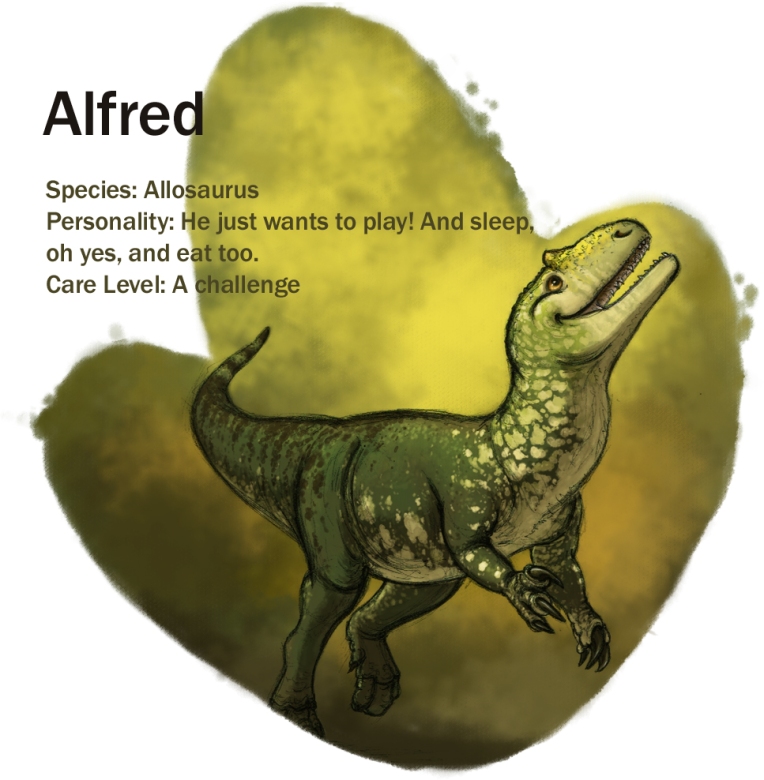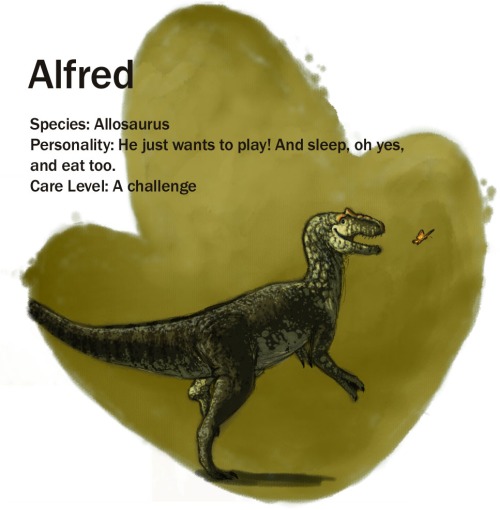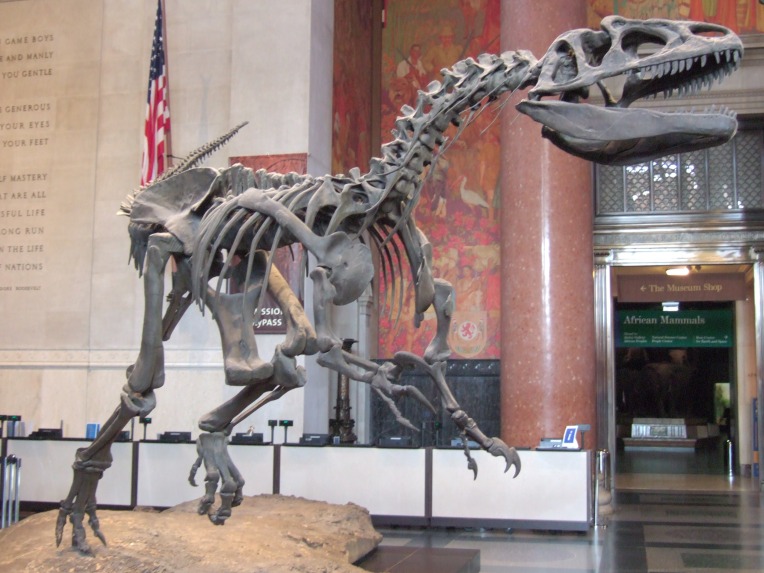Meet Alfred. The lion of the Jurassic! The prince of the Mesozoic! The…oh, there he goes after another butterfly. All he needs to be happy in life is his food, his chew toy, and a nice long nap.

Looks like Alfred has found something to chase. No worries though, that butterfly has nothing to fear, and he’ll give up soon enough. Allosaurus (ah-low-saw-rus) wasn’t very fast, but he can’t help it- if it runs off, he’s got to chase it! After a quick sprint, Alfred loves to settle under the shade of a tree and take a nice nap.
What’s that you say? He’s a fearsome predator? Well yes, yes he is. Take a quick look at lions, and tigers, and bears (oh my!), and most of the time you’ll actually catch them napping. Crocodiles and eagles, Alfred’s closest living relatives, also do a lot of nothing. Once you have a full belly, why not enjoy a siesta in the sun? 🙂
You can find out more about Alfred at his critter page.
Making progress…
Woohoo! It’s later than I normally post in the day, but Alfred finally got an update! He really needed one, since he’s one of my earliest critters in the shop now (since just about everyone else has gotten an update).
I referenced the original one from a sculpture by David Krentz, and I didn’t feel comfortable referencing it so exactly. See?


So…I found a lovely picture of a mounted skeleton instead, and fleshed it out. 😀 The photo isn’t mine, so I never went to the museum, but you can find out all about it by clicking on the picture.
I like this mount because the skeleton is not as squished as you usually see. I’m not 100% if the ribs should be quite so splayed out like that, you always have to be careful to get pictures of a good mount if you’re using them for reference. But this one looks to be a well done mount from the research I can gather.
For starters, it’s really nice that the teeth are properly in their sockets, and not halfway falling out like you see in a lot of mounts. Those tiny teeth you see would’t be visible in life, because the gum line would’ve covered them. They’re new ones coming in. 🙂
It’s also really nice to see a skull that isn’t squished too thin, or the top jaw crushed down over the bottom jaw far more than it ever would be in life. I see many reconstructions with the top teeth almost hanging past the chin when closed, because they look at skulls that are preserved with features of decay and time.
When an animal dies, the gums deteriorate and pull back from the teeth, so teeth are often loose or fall out after death. People who reconstruct dinosaurs that preserve these features will have animals with teeth twice as long as they should be.
Other times, time and the pressure of the earth above the forming fossil will push the top jaw down onto the lower jaw, especially when there is less soft tissue to hold it in place. So you end up with skulls where the bottom teeth are touching the roof of the mouth, and closed far more than it ever would be in life.
The same thing can also happen when the muscles that close the jaw dry out and turn to jerky. The loss of moisture and tightening of the muscles after death and position bones in some odd ways before fossilization.
With both of these cases of preservation, the possibility of lips of any kind is obviously impossible. Looking at preserved skulls with extra long teeth and jaws shut tight, it would look like even lizard lips would be shredded to ribbons every time Alfred closed his mouth!
So it’s a good thing we have clues on the bone, and modern analogues to look at. 🙂 You can find out a few more details on that over at “The Art and Science of Alfred”.
You can click on the quotes to get to the link, but for now, let’s just say that Alfred’s lips are partly an artistic choice but also backed by plenty of research. 🙂
Oh, and if you’ve read the news about those papers claiming that T-rex definitely had a croc-face with no lips…the people who wrote the news articles didn’t read the paper. The authors of the paper only determined that T-rex had a very sensitive snout, just like crocs. They didn’t say anything concretely about lips or no lips.
Just sayin’ ;P It’s not a set in stone deal yet. 😀
Coming Next Week…
A giant with a heart of gold, life is never boring when this big guy is around. Nothing is out of reach! He’ll stick his nose into everything until every mystery is solved.
Share your guess in the comments! He’ll be one of the critters over on the critter page. 🙂


As I said before Allosaurus is my favorite dinosaur. What’s your favorite dinosaur
LikeLike
Stegosaurus and Dilophosaurus are two of my favorites. I have a hard time choosing just one. 🙂
LikeLike
Yes for those that don’t know theropods, like sharks, crocodiles and other reptiles lost and repased teeth all the time. Dull or old ones with new sharper ones this was neseasere because they would lose teeth in srugales with pray
LikeLike
I’m not saying 🦈 are 🦎 I’m saying that they both lose and replace teeth in the same way
LikeLike
Your new Allosaurus design looks great! I’m glad that my photo of the Allosaurus skeleton at the American Museum of Natural History helped you out.
LikeLike
Thank you! It’s been incredibly helpful to have such great pictures of this mount to work with. Thank you sharing them! ☺️
LikeLiked by 1 person
Ooh… 😀 Nice! You’ve really improved, and in just a year! I like how the style has evolved, too. :3 It looks very three-dimensional now. It’s also cleaner and more appealing, though it still has that nice sketchy look. Just out of curiosity, what’s the little horn on his head for?
LikeLike
Thank you Brownie! I’m glad you like him, I’m rather pleased with how he turned out. It took a year to obtain the skill required, but I finally got the image in my head out onto the screen. 😀
Alfred actually has two little horns, one over each eye. It’s pretty common in theropods, or even in reptiles like crocs, lizards, and snakes (even birds if I’m not mistaken). There are a couple for reasons for this.
– A structural thing. A lightweight skull exposed to repeated stress, such as biting down on a carcass (hunting or scavenging), requires a lot of reinforcement. So you tend to see a lot of hornlets, thickened brow ridges, and thickened nasal ridges in animals that have stronger bite forces.
– Appearances, and not just courtship or display. In animals that tend to have a lot of face-biting competitions, it helps if you have some thick brow ridges or hornlets to protect your eyes. In many cases for face-biting birds (and we assume dinosaurs), these areas just above the eyes have bright, obvious colors, or pure white compared to darker faces. The aggressor tends to bite or peck at the brighter, more obvious “eye” spot. So the defender just gets a scratch or two instead of losing an eye. 🙂
After studying pictures of Allosaurus skuls, I gave Alfred a conservative layer of keratin and thick, cornified skin on his face. A combo of hard croc skin and the fleshier, but equally as tough skin on turkey wattles.
You can read more on Mark Witton’s blog or on the blog Antediluvian Salad. Both talk about the plausibility of thick skin and keratin, and the habit of face-biting in theropods like Alfred. 🙂
LikeLike
I love the new Alfred design! Looks much cuter than before,and i never realized the reference for design of the old one. Oh no,looks like Dippy is chasing the ball! He got to the COTW train! That wasn’t meant to happen. 😀
LikeLike
Thank you Kaprosaurus, I’m glad you like him! I must I’m rather pleased with him too. 😀 I was never really very happy with the other one, but this new update is exactly what I was trying to achieve with the old one! Amazing how a little time and a little more skill can make such a big difference. 🙂
Yup, Dippy is up to his antics again. Looks like the ball won this round, since it got him on the train. 😀
Thank you for stopping by! 🙂
LikeLike